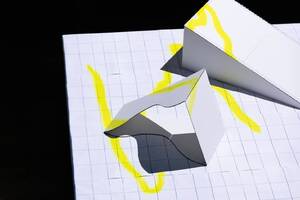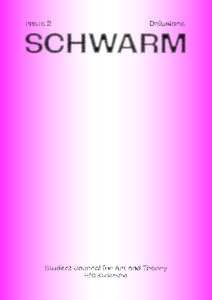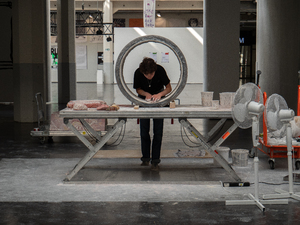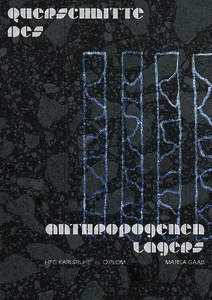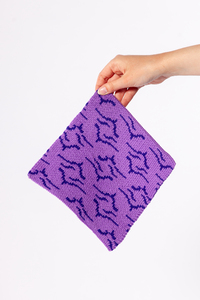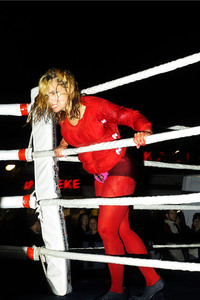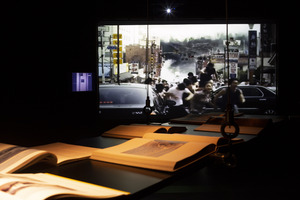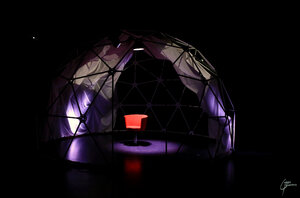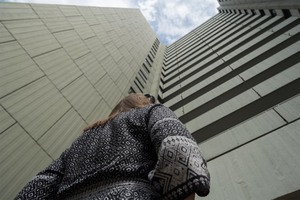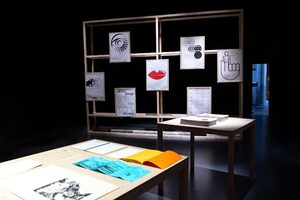„Infanterie, Cavallerie, Artillerie“ statt „Liberté, égalite, fraternité“: Das Komische als Kampfmittel in Karl Marx' "Der achtzehnte Brumaire des Louis Bonaparte"
Benachbarte Sets (29)Alle Zusammenhänge anzeigen
Diese Sets wurden den gleichen Sets hinzugefügt wie das ausgewählte Set.
29 Inhalte
- Seite 1 von 3
Roll a boulder
- Titel
- Roll a boulder
- Titel (en)
- Roll a boulder
- Autor/in
- Beschreibung (de)
- In diesem Stück erkunde ich die Sinnlosigkeit des Lebens durch die Verschmelzung von Skateboarding und greife dabei auf das Bildnis des Sisyphos aus der griechischen Mythologie zurück, das den Felsen schiebt. Ich habe einen Raum von 8*5 Metern konstruiert, umgeben von Skateboard-Soundeffekten unten und Projektion Animationen oben. Die Trajektorie des Skateboards schreitet kontinuierlich voran, dreht sich und scheitert letztendlich auf dem Gelände, ähnlich wie Sisyphos, der endlos den Felsen schiebt und in einem unendlichen Zyklus von Anstrengung und Scheitern gefangen ist.
Die lebendigen animierten Skateboard-Spuren vermitteln Spannung und surreale visuelle Ausdrücke. Die Anstrengung des Skateboardens entspricht dem endlosen Rollen des Felsens und regt zur Reflexion über die Bedeutung des Lebens an. Zuschauer reflektieren in dieser Umgebung kontinuierlich über die Vergänglichkeit des Lebens und die Bedeutung von Anstrengung, was die widersprüchlichen Gefühle der Menschheit gegenüber dem Dasein widerspiegelt. Diese Szene ist nicht nur eine visuelle Freude, sondern dient auch als spirituelle Erleuchtung und Reflexion.
- In diesem Stück erkunde ich die Sinnlosigkeit des Lebens durch die Verschmelzung von Skateboarding und greife dabei auf das Bildnis des Sisyphos aus der griechischen Mythologie zurück, das den Felsen schiebt. Ich habe einen Raum von 8*5 Metern konstruiert, umgeben von Skateboard-Soundeffekten unten und Projektion Animationen oben. Die Trajektorie des Skateboards schreitet kontinuierlich voran, dreht sich und scheitert letztendlich auf dem Gelände, ähnlich wie Sisyphos, der endlos den Felsen schiebt und in einem unendlichen Zyklus von Anstrengung und Scheitern gefangen ist.
- Beschreibung (en)
- In this piece, drawing upon the imagery of Sisyphus from Greek mythology pushing the boulder, I explore the meaninglessness of life through the fusion of skateboarding. I constructed a space measuring 8*5 meters, enveloped in skateboard sound effects below and projection animations above. The skateboard's trajectory continually progresses, turns, and ultimately fails on the terrain, resembling Sisyphus endlessly pushing the boulder, caught in an infinite cycle of effort and failure.
The vibrant animated skateboard tracks convey tension and surreal visual expressions. The effort of skateboarding parallels the endless rolling of the boulder, prompting contemplation on the meaning of life. Spectators continually ponder the transience of life and the significance of effort in this setting, reflecting humanity's contradictory feelings towards existence. This scene is not just a visual delight but also serves as a spiritual enlightenment and reflection.
- In this piece, drawing upon the imagery of Sisyphus from Greek mythology pushing the boulder, I explore the meaninglessness of life through the fusion of skateboarding. I constructed a space measuring 8*5 meters, enveloped in skateboard sound effects below and projection animations above. The skateboard's trajectory continually progresses, turns, and ultimately fails on the terrain, resembling Sisyphus endlessly pushing the boulder, caught in an infinite cycle of effort and failure.
- Typ des Projekts/Werks
- Schlagworte
- Datierung
- 18.01.2024
- Mitwirkende
- Dank an
- Sprache
- Material
- Abmessungen
- 8m x 5m
- Dauer
- 1 Tag
- Ort: Institution
- Ort
- Lichthof
- Stadt
- Land
- Titel
- Roll a boulder
- Projektleiter/in
- Semester
- Studiengang
- Typ der Abschlussarbeit
- Importiert am
- 15.04.2024
- Übergeordnete Sets
- 2
- Set enthält
- 0 12
Vordiplom Hannah Gebert
- Titel
- Vordiplom Hannah Gebert
- Titel (en)
- "fake it till you make it"
- Autor/in
- Beschreibung (de)
- Stuckmarmor ist eine historische Stucktechnik des 16. und 17. Jahrhunderts aus Italien, die für ihre Marmorimitation bekannt ist. Dabei wurden Gips, Wasser, Pigmente und tierischer Leim gemischt, um marmorähnliche Oberflächen zu schaffen.
"Fake it till you make it" ist eine Erkundung dieses traditionellen Handwerks. Ziel ist es, die alte Kunst der Marmorimitation wiederzubeleben und ihre ästhetischen Werte in der heutigen Welt zu präsentieren. Darüber hinaus befasst sich das Projekt mit der Frage, was "echt" und was "unecht" ist, und untersucht die Rolle der Inszenierung. Inspiriert von den drei Teilen einer Säule (Basis, Schaft, Kapitell) habe ich drei Objekte entwickelt, die als Einzelstücke im Raum zu finden sind. Alle drei Objekte sind aus Holz gefertigt, zwei davon durch ein Stahlgerüst stabilisiert. Die Unterkonstruktion wurde dann mit Streckmetall verkleidet, verputzt und diente schließlich als Untergrund für den Stuckmarmor. Ein Making-of-Video zeigt die Herstellung des Stuckmarmors. Jedes der Objekte ist auf eine andere Art und Weise verkleidet, um die Konstruktion nicht immer zu verbergen, sondern sie vielmehr zu enthüllen, ganz nach dem Motto "fake it till you make it".
- Stuckmarmor ist eine historische Stucktechnik des 16. und 17. Jahrhunderts aus Italien, die für ihre Marmorimitation bekannt ist. Dabei wurden Gips, Wasser, Pigmente und tierischer Leim gemischt, um marmorähnliche Oberflächen zu schaffen.
- Beschreibung (en)
- Stucco marble is a historic plasterwork technique originating from 16th and 17th-century Italy, celebrated for its imitation of marble. This involved blending gypsum plaster, water, pigments, and animal glue to create marble-like surfaces.
„fake it till you make it“ is an exploration of this traditional craft of stucco marble. The aim is to revive the ancient art of imitating marble and to present its aesthetic values in today‘s world. In addition, the project will address the question of what is „real“ and what is „fake“ and examine the role of staging. Inspired by the three parts of a column (base, shaft, capital) I have developed three objects that can be found as individual pieces in the room. All three objects are made of wood, two of them stabilized by a steel framework. Ribbed expanded metal lath was then stapled onto the wood and plastered, serving as the base for the stucco marble. A making of video shows the production of the stucco marble. Each of the objects is covered in a different way, intended not to always conceal the construction but rather to reveal it, embodying the spirit of „fake it till you make it.“
- Stucco marble is a historic plasterwork technique originating from 16th and 17th-century Italy, celebrated for its imitation of marble. This involved blending gypsum plaster, water, pigments, and animal glue to create marble-like surfaces.
- Kategorie
- Typ des Projekts/Werks
- Schlagworte
- Datierung
- 25.06.2024
- Material
- Ort: Institution
- Ort
- An der Säule unter der Lichtbrücke
- Stadt
- Land
- Titel
- Vordiplom Hannah Gebert
- Projektleiter/in
- Studiengang
- Importiert am
- 22.05.2024
- Übergeordnete Sets
- 0
- Set enthält
- 0 13
Querschnitte des anthropogenen Lagers
- Titel
- Querschnitte des anthropogenen Lagers
- Titel (en)
- Cross-sections of the anthropogenic material stock
- Autor/in
- Beschreibung (de)
- Die Arbeit "Querschnitte des anthropogenen Lagers" setzt sich konzeptionell und praktisch mit der Wiederverwendung von Bauschutt auseinander.
Ein Großteil des in Deutschland aufkommenden Abfalls entsteht im Bausektor in Form von mineralischem Bauschutt und wird meist nur in abgewerteter Form wieder in den Kreislauf eingebracht.
Durch das Besuchen verschiedener Baustellen und Deponien, das Dokumentieren, Sammeln, Sortieren, und Fotografieren der vorgefundenen Materialien und Formen, wurden die noch vorhandenen formalen und optischen Qualitäten des anfallenden Materials analysiert, ergründet und Konzepte entwickelt, wie diese wieder im gleichen Bereich ihres Ursprungs Verwendung finden können.
Dabei wurden durch Querschnitte durch das Material die schon vorhandenen Qualitäten, wie die zylindrische Form von Bohrkernen oder die Terrazzo-Optik im Inneren von Betonbrocken, zum Vorschein gebracht, betont und in einen nutzbaren Kontext gesetzt. Die entstandenen Materialscheiben können durch verschiedene Verbindungstechniken als architektonische Halbzeuge genutzt und in Wandpaneele, Fliesen oder Fassadenelemente eingebracht werden.
- Die Arbeit "Querschnitte des anthropogenen Lagers" setzt sich konzeptionell und praktisch mit der Wiederverwendung von Bauschutt auseinander.
- Beschreibung (en)
- The work "Cross-sections of the anthropogenic material stock" deals conceptually and practically with the reuse of construction waste.
A large part of the waste generated in Germany is produced in the construction sector in the form of mineral building rubble and is usually only recycled in a downgraded form.
By visiting various construction sites and landfills, documenting, collecting, sorting and photographing the materials and shapes found, the remaining formal and visual qualities of the accumulated material were analysed, explored and concepts were developed on how they could be reused in the same area of their origin.
The existing qualities, such as the cylindrical shape of drill cores or the terrazzo look inside chunks of concrete, were brought to light, emphasised and placed in a usable context by making cross-sections through the material. The resulting material discs can be used as architectural semi-finis.
- The work "Cross-sections of the anthropogenic material stock" deals conceptually and practically with the reuse of construction waste.
- Kategorie
- Typ des Projekts/Werks
- Schlagworte
- Datierung
- 30.10.2023
- Titel
- Querschnitte des anthropogenen Lagers
- Projektleiter/in
- Semester
- Studiengang
- Typ der Abschlussarbeit
- Importiert am
- 27.05.2024
- Übergeordnete Sets
- 2
- Set enthält
- 0 23
Visitors
- Titel
- Visitors
- Autor/in
- Beschreibung (en)
- “Visitors” takes as its focus the works of international students from HfG Karlsruhe. The exhibition aims to shed light on the different geographical, political and economic backgrounds that come together in our institution. Two main resources for our work will be HfG's archiving platform Madek and its analogue exhibition interface Portal that the HfG Open Resource Center has been developing.
How do people from abroad who study at the HfG shape the place? How do international students contribute to and challenge the HfG? We will work on preparing and realizing an exhibition based on diploma works of international students from previous generations.
For Visitors we have imagined an alternative geography or an alternative biography of HfG. It is designed around people who ‘visit’ and explore what that challenging gesture means.
- “Visitors” takes as its focus the works of international students from HfG Karlsruhe. The exhibition aims to shed light on the different geographical, political and economic backgrounds that come together in our institution. Two main resources for our work will be HfG's archiving platform Madek and its analogue exhibition interface Portal that the HfG Open Resource Center has been developing.
- Typ des Projekts/Werks
- Mitwirkende
- Sprache
- Titel
- Visitors
- Importiert am
- 27.05.2024
- Übergeordnete Sets
- 0
- Set enthält
- 0 0
Path Tiles
- Titel
- Path Tiles
- Titel (en)
- Path Tiles
- Untertitel
- Knitting Coordinates into Patterns
- Untertitel des Projekts/Werks (en)
- Knitting Coordinates into Patterns
- Autor/in
- Beschreibung (de)
- Unsere Bewegungen können wie eine Performance begriffen werden, wie etwas Flüchtiges, das nur im Moment existiert und nach der Vollendung weder sichtbar noch fassbar ist. Nur die Erinnerungen an das Erlebte bleiben als Spuren der Bewegung in unserem Geist erhalten. Path Tiles nutzt GPS-Daten, um diese besonderen Momente individueller Erfahrung einzufangen und in Form von Mustern in die physische Welt des sicht- und tastbaren Textils zu übertragen. Es entsteht eine tiefe Bindung zwischen Mensch und Objekt.
Jedes Muster steht für eine Reise, für eine Erfahrung. Dabei ist es egal, ob es sich um einen Spaziergang in der Natur, eine Reise in ein fernes Land oder einen wiederkehrenden Weg des Alltags handelt. Die daraus entstehenden Muster erzählen von den Gefühlen und Begegnungen, von dem Gesehenen und dem Erlebten und erinnern uns an das, was uns ausmacht.
Mit der Path Tiles Website habe ich ein Werkzeug entwickelt, um diese Reisen in Form von GPS-Daten in strickbare Muster zu verwandeln. Ich habe die Website so gestaltet, dass die Ästhetik des Musters durch zusätzliche Verschiebung, Verzerrung und Spiegelung individualisiert werden kann. Dies stellt außerdem sicher, dass Menschen mit der gleichen Strecke trotzdem persönliche Muster erstellen können. Das entstandene Muster wird dann in Form eines gestricktes Objekts zum Leben erweckt und wird zur materialisierten persönlichen Erfahrung. Durch die Einbeziehung des Nutzers in den Gestaltungsprozess entsteht eine weitere Ebene der Bindung zwischen Mensch und Objekt.
Für das Diplom habe ich exemplarisch fünf Objekte gestaltet, die mit diesen Mustern personalisiert werden können. Das Design der Objekte konzentriert sich darauf, das Reisen oder das „unterwegs sein“ in verschiedenen Situationen zu erleichtern. In diesem Prozess ist ein Schal mit Taschen, ein Umhang, der gleichzeitig als Decke genutzt werden kann, eine Tasche, die zugleich ein Kissen ist, eine Balaklava mit Ohrenschützern und ein Nackenkissen mit Rückenstütze und Taschen in den verlängerten Seitenteilen entstanden.
Für die finale Herstellung der Objekte haben fünf Personen die GPS-Daten verschiedener Routen verwendet um ihre persönlichen Muster auf der Path Tiles Website zu erstellen. Jedes der Objekte wurde zu einer Person, einer Reise, einem Muster zugeordnet und entsprechend produziert. Die fertigen Objekte sind die materialisierten Erfahrungen und Erinnerungen dieser Menschen.
Begleitend zu dieser Arbeit habe ich mit der Sammlung von Reisen in Form von Geschichten und Mustern begonnen. Hierbei ist ein kleines Booklet entstanden, das die Beiträge von 19 Menschen beinhaltet. Sie alle haben eine Erinnerung von einer Reise in Form von Text und Muster mit mir geteilt.
- Unsere Bewegungen können wie eine Performance begriffen werden, wie etwas Flüchtiges, das nur im Moment existiert und nach der Vollendung weder sichtbar noch fassbar ist. Nur die Erinnerungen an das Erlebte bleiben als Spuren der Bewegung in unserem Geist erhalten. Path Tiles nutzt GPS-Daten, um diese besonderen Momente individueller Erfahrung einzufangen und in Form von Mustern in die physische Welt des sicht- und tastbaren Textils zu übertragen. Es entsteht eine tiefe Bindung zwischen Mensch und Objekt.
- Beschreibung (en)
- Movement is like a performance, something momentous becoming invisible and untouchable as soon as it is complete. Only the memories of the experience remain as traces of the movement in our minds. Path Tiles captures these valuable moments of individual experiences and transfers them into the physical world of visible and tactile textiles, creating a deep relationship between person and object.
Each pattern represents a journey, an experience. It doesn't matter whether it's a walk in nature, a trip to a distant country, or a repeating path in everyday life. The resulting patterns tell of the emotions evoked by landscapes, the lessons learned along the way and the power of the journey to shape our lives.
With the Path Tiles website, I have developed a tool to transform these journeys into knitable patterns using GPS data. I designed the website so that the aesthetics of the pattern can be individualized through shifting, distorting, and mirroring. This ensures that even people with the same route can create personal patterns. The resulting pattern is then brought to life in the form of a knitted object, becoming a materialized personal experience. By involving the user in the design process, an additional layer of connection between person and object is created.
For my diploma, I have designed five objects that can be personalized with these patterns. The design of these objects focuses on making travelling or being "on the go" more comfortable. This process has resulted in the creation of a scarf with pockets, a cape that can also be used as a blanket, a bag that doubles as a pillow, a balaclava with ear cushions, and a neck pillow with back support and pockets in the extended side parts.
For the final production of the objects, five people used the GPS data of different routes to create their personal patterns on the Path Tiles website. Each of the objects was assigned to a person, a journey, a pattern, and then produced accordingly. The finished objects are the materialized experiences and memories of these people.
Accompanying this work, I have started collecting journeys in the form of stories and patterns. This resulted in a small booklet that includes contributions from 19 people. They all shared a memory of a journey in the form of text and pattern with me.
- Movement is like a performance, something momentous becoming invisible and untouchable as soon as it is complete. Only the memories of the experience remain as traces of the movement in our minds. Path Tiles captures these valuable moments of individual experiences and transfers them into the physical world of visible and tactile textiles, creating a deep relationship between person and object.
- Kategorie
- Typ des Projekts/Werks
- Schlagworte
- Datierung
- April 2024
- Mitwirkende
- Dank an
- Material
- Ort: Institution
- Internetlinks
- Bemerkungen
- Die Diplomarbeit wurde von Prof. Wieki Somers und Prof. Céline Condorelli betreut.
- Titel
- Path Tiles
- Projektleiter/in
- Semester
- Studiengang
- Typ der Abschlussarbeit
- Importiert am
- 28.05.2024
- Übergeordnete Sets
- 2
- Set enthält
- 0 42
Afterfire Seminar
- Titel
- Afterfire Seminar
- Beschreibung (de)
- Mit einer Kombination aus praktischen, experimentellen und forschungsbasierten Ansätzen und einem Fokus auf Materialien untersuchten Studierende und Lehrende im Seminar Afterfire unsere Beziehung zum Feuer im Laufe der Geschichte und im Vergleich zu heute. Geleitet von den Gastprofessoren Paco Boekelmann und Kevin Rouff von Studio Thusthat fand das Seminar im Wintersemester 2022/23 an der HfG Karlsruhe statt.
In einer Zeit von Kriegen, knappen Energieressourcen und der Klimakrise konzentrierte sich das Afterfire Seminar auf unsere besondere Übergangszeit, in der wir uns (theoretisch) von fossilen Brennstoffen entfernen und nach neuen Feuerquellen suchen. In Vorträgen, Gastvorträgen, Ortsbesichtigungen, Workshops und Einzelarbeiten untersuchten Studierende und Lehrende die Nutzung von Feuer und verschiedenen Brennstoffen im Laufe der Jahrhunderte und konzentrierten sich dabei auf das, was nach dem Feuer übrig bleibt - die Asche.
Nach einem Besuch des Kohlekraftwerks im Karlsruher Rheinhafen organisierte Studio Thusthat einen Workshop, um den Vorläufer der Steinkohle zu erforschen: die Holzkohle. Die Studierenden schufen Werkstücke, hauptsächlich aus Holz, und bauten einen Ofen, in dem alle Objekte am letzten Tag des Workshops ohne Sauerstoff gebrannt wurden, so dass sie zu Holzkohle wurden.
Der zweite Workshop konzentrierte sich auf die drei "neuen" wichtigsten alternativen Brennstoffsektoren: den Bereich der holzigen Biomasse, den Bereich der landwirtschaftlichen Nebenprodukte und den Bereich der Energiegewinnung aus Abfällen. Zwei Tage lang analysierten die Studierenden in Gruppenarbeit die repräsentativen Brennstoffe Holz, Stroh und Siedlungsabfälle im Hinblick auf die vielen Nuancen, die für und gegen ihre Nutzung als Energiequelle sprechen.
Neben und in Verbindung mit den Workshops wurden im Laufe des Semesters individuelle studentische Projekte entwickelt, die auf den Recherchen von Studio Thusthat aufbauten und eigene Prozesse, Phänomene, Effekte oder Zusammenhänge von Feuer theoretisch und praktisch erarbeiteten.
Am Ende des Semesters wurden alle studentischen Projekte in einer Ausstellung im Lichthof der HfG Karlsruhe präsentiert, wo die Projekte der Öffentlichkeit präsentiert wurden. Eine Auswahl der Projekte, an denen die Studierenden über das Seminar hinaus weitergearbeitet haben, wurde beim Rundgang und bei der Karlsruher Museumsnacht 2023 ausgestellt.
- Mit einer Kombination aus praktischen, experimentellen und forschungsbasierten Ansätzen und einem Fokus auf Materialien untersuchten Studierende und Lehrende im Seminar Afterfire unsere Beziehung zum Feuer im Laufe der Geschichte und im Vergleich zu heute. Geleitet von den Gastprofessoren Paco Boekelmann und Kevin Rouff von Studio Thusthat fand das Seminar im Wintersemester 2022/23 an der HfG Karlsruhe statt.
- Beschreibung (en)
- With a combination of practical, experimental and research-based approaches and a focus on materials, students and teachers in the Afterfire seminar examined our relationship to fire throughout history and in comparison to today. Led by guest professors Paco Boekelmann and Kevin Rouff from Studio Thusthat, the seminar took place in the winter semester 2022/23 at the HfG Karlsruhe.
In a time of wars, scarce energy resources and climate crisis, the Afterfire Seminar focused on our particular transitional period in which we are (theoretically) moving away from fossil fuels and looking for new sources of fire. Through lectures, guest talks, site visits, workshops and individual work, students and teachers explored the use of fire and different fuels over the centuries, focussing on what remains after the fire - the ash.
Following a visit to the coal-fired power station in Karlsruhe's Rheinhafen, Studio Thusthat organised a workshop to explore the precursor to hard coal: charcoal. The students created workpieces, mainly out of wood, and built a kiln in which all the objects were burnt without oxygen on the last day of the workshop, turning them into charcoal.
The second workshop focussed on the three "new" main alternative fuel sectors: the woody biomass sector, the agricultural by-products sector and the waste-to-energy sector. For two days, students worked in groups to analyse the representative fuels wood, straw and municipal waste with regard to the many nuances that speak both for and against their use as an energy source.
Alongside and in conjunction with the workshops, individual student projects were developed throughout the semester, which built on Studio Thusthat's research and worked out their own processes, phenomena, effects or connections of fire in theory and practice.
At the end of the semester, all student projects were presented in an exhibition in the Lichthof of the HfG Karlsruhe, where the projects were explained and shown to the public. A selection of the projects on which students continued to work beyond the seminar was exhibited during the Rundgang and at the Karlsruhe Museumsnacht 2023.
- With a combination of practical, experimental and research-based approaches and a focus on materials, students and teachers in the Afterfire seminar examined our relationship to fire throughout history and in comparison to today. Led by guest professors Paco Boekelmann and Kevin Rouff from Studio Thusthat, the seminar took place in the winter semester 2022/23 at the HfG Karlsruhe.
- Kategorie
- Typ des Projekts/Werks
- Mitwirkende
- Sprache
- Titel
- Afterfire Seminar
- Importiert am
- 10.06.2024
- Übergeordnete Sets
- 0
- Set enthält
- 3 0
WWWE
- Titel
- WWWE
- Titel (en)
- WWWE
- Untertitel
- World Women Wrestling Entertainment
- Untertitel des Projekts/Werks (en)
- World Women Wrestling Entertainment
- Autor/in
- Beschreibung (de)
- WWWE ist eine 40-minütige, performative Wrestlingshow im öffentlichen Raum. Im Mittelpunkt stehen zwei Frauen, deren Crew, eine Band* und eine Moderatorin, die sich gemeinsam mit dem Publikum im Wrestling ausprobieren und die gesellschaftliche Tabuisierung von wütenden Frauen im Ring verhandeln. Wie im Schaukampf üblich, sind die Handlungsabläufe teilweise improvisiert und werden mit Showelementen und Storylines angereichert.
- Beschreibung (en)
- WWWE is a 40-minute performative wrestling show in public space. The focus is on two women, their crew, a band* and a presenter who try their hand at wrestling together with the audience and negotiate the social taboo of angry women in the ring. As is usual in exhibition wrestling, the action is partly improvised and enriched with show elements and storylines.
- Kategorie
- Schlagworte
- Datierung
- 26.09.2019, 19 Uhr, Live
- Mitwirkende
- Stadt
- Land
- Internetlinks
- Bemerkungen
- Sponsoring: Bulldog Gym Karlsruhe, Hfg Karksruhe, Kulturbüro Karlsruhe LBBW Bank
- Sponsoring: Bulldog Gym Karlsruhe, Hfg Karksruhe, Kulturbüro Karlsruhe LBBW Bank
- Titel
- WWWE
- Projektleiter/in
- Semester
- Studiengang
- Typ der Abschlussarbeit
- Importiert am
- 13.06.2024
- Übergeordnete Sets
- 1
- Set enthält
- 0 16
Tide
- Titel
- Tide
- Titel (en)
- Tide
- Autor/in
- Beschreibung (de)
- Gezeiten sind dem Zyklus von Sonne, Erde und Mond unterworfen. Sie sind die Bewegung der Wassermassen des Ozeans, die an den Küsten als periodisches Ansteigen und Absinken des Meeresspiegels in Erscheinung tritt. [...] Gezeiten als Daseinsmetapher umreißen das fortlaufende Ausbalancieren von Kommen und Gehen, Anziehen und Abstoßen, Sich zeigen und entziehen. [...] "Tide" überträgt dieses Verständnis der Gezeiten in eine kontinuierliche, non-lineare Bewegung im Ausstellungsraum.
- Beschreibung (en)
- Tides are subject to the cycle of the sun, earth and moon. They are the movement of the water masses of the ocean, which appears on the coasts as a periodic rise and fall of the sea level. [...] Tides as a metaphor for existence outline the continuous balancing of coming and going, attracting and repelling, showing and withdrawing. [...] "Tide" translates this understanding of the tides into a continuous, non-linear movement in the exhibition space.
- Kategorie
- Schlagworte
- Datierung
- 01.07.2020 - 05.07.2020
- Dank an
- Francesca Audretsch
- Patrick Alan Banfield
- Lisa Bergmann
- Matthias Bruhn
- Anja Casser
- Hans Christ (Hans D. Christ)
- Jaya Demmer
- Hubert Distel
- Anja Dorn
- Lizzy Ellbrück
- Hanna Franke
- Christoph Funk
- Laurine Haller
- Maria Harder-Scheib
- Sascha Jungbauer
- Lydia Kähny
- Tobias Keilbach
- Iden Sungyoung Kim
- Alexander Knoppik
- Hanne König
- Susanne Kriemann
- Judith Milz
- Paulina Mimberg
- Andrej Mircev
- Andreas Müller
- Viktor Neumann
- Leonie Ohlow
- Jonas Piroth
- Anja Ruschival
- Thomas Rustemeyer
- Sebastian Schäfer
- Friederike Schäfer
- Karl-Heinz Scheib
- Ivo Scheib
- Corinna Scheib
- Josefine Scheu
- Hendrik Stoerk
- Lioudmila Voropai
- Leia Morgana Walz
- Petra Zimmermann
- Ort: Institution
- Ort
- Großes Studio
- Stadt
- Land
- Titel
- Tide
- Projektleiter/in
- Semester
- Studiengang
- Typ der Abschlussarbeit
- Importiert am
- 14.06.2024
- Übergeordnete Sets
- 1
- Set enthält
- 0 15
ERLEBNIS THEATER
- Titel
- ERLEBNIS THEATER
- Untertitel
- Für eine wahrnehmungszentrierte Raumtheorie im Theater
- Untertitel des Projekts/Werks (en)
- For a perception-centered theory of space in the theater
- Autor/in
- Beschreibung (de)
- Das Projekt behandelt die sensitive Wahrnehmung in Räumen und kritisiert dessen Nicht-Vorhandensein speziell in Theater-Architekturen.
- Beschreibung (en)
- The project deals with sensitive perception in spaces and criticizes its non-existence, especially in theater architecture.
- Kategorie
- Schlagworte
- Datierung
- Mai 2021
- Mitwirkende
- Ort: Institution
- Ort
- Großes Studio
- Stadt
- Land
- Internetlinks
- Titel
- ERLEBNIS THEATER
- Projektleiter/in
- Semester
- Studiengang
- Typ der Abschlussarbeit
- Importiert am
- 14.06.2024
- Übergeordnete Sets
- 1
- Set enthält
- 0 11
HOCHHAUS Audiowalk
- Titel
- HOCHHAUS Audiowalk
- Autor/in
- Beschreibung (de)
- Der HOCHHAUS Audiowalk führt die Teilnehmer*innen an spezifische Orte des Hochhauses der Kaiserallee 15 in Karlsruhe und lässt das Gebäude zum Hauptakteur werden. In neun Audiotracks werden collageartig Texte aus verschiedenen Perspektiven verarbeitet.
- Beschreibung (en)
- The HOCHHAUS audio walk takes participants to specific locations in the high-rise building at Kaiserallee 15 in Karlsruhe, making the building the main protagonist. In nine audio tracks, texts from different perspectives are collaged together.
- Kategorie
- Typ des Projekts/Werks
- Schlagworte
- Datierung
- 20.07.2019
- Mitwirkende
- Dauer
- 55 min
- Ort
- Hochhaus Kaiserallee 15
- Stadt
- Land
- Bemerkungen
- Referenzen:
J.G. Ballard: Hochhaus
EWG Wohnzentrum Kaiserallee Informationsprospekt von 1968
Interviews mit Bewohner*innen der Kaiserallee 15
Interview mit Hausmeister der Kaiserallee 15
George Perec: Träume von Räumen
Unter der Verwendung von:
Magix Music Maker
Mit Sounds und Musik von:
white bicycle
Title: April Sun Playalong
Link: https://www.audiyou.de/beitrag/april-sun-playalong…
(Veränderungen wurden vorgenommen)
Starscade
Title: sfx-radio-static.flac
Link: https://freesound.org/people/Starscade/sounds/3973…
(Veränderungen wurden vorgenommen)
Satuniman
Title: Gramophone
Link: https://freesound.org/people/Setuniman/sounds/1785…
(Veränderungen wurden vorgenommen)
- Referenzen:
- Titel
- HOCHHAUS Audiowalk
- Projektleiter/in
- Semester
- Studiengang
- Typ der Abschlussarbeit
- Importiert am
- 14.06.2024
- Übergeordnete Sets
- 1
- Set enthält
- 0 15
all the things you are.
- Titel
- all the things you are.
- Untertitel
- Die Lebenszeichen von Wolfgang Schmidt
- Untertitel des Projekts/Werks (en)
- Signs of life from Wolfgang Schmidt
- Autor/in
- Beschreibung (de)
- Der Künstler und Grafiker Wolfgang Schmidt (* 24. Juli 1929; † 8. März 1995) begann 1972 mit der Gestaltung seines individuellen Zeichensystems: Den Lebenszeichen. Bis 1979 waren von den geplanten 893 Zeichen 262 fertiggestellt, in Kombination miteinander ergeben sich aus ihnen über 394 Variationen. [...] Die Ausstellung "all the things you are." geht diesem Katalog nach und zeigt neben originalen Drucken, auch eine Auswahl an Manuskripten und Plänen. [...] Die Exponate in der Ausstellung werden durch neu entstandene Arbeiten ergänzt, welche die durch Schmidts Zeichensystem aufgeworfenen Fragen nach Identität, Emotion und Kommunikation aufgreifen.
- Beschreibung (en)
- The artist and graphic designer Wolfgang Schmidt (* July 24, 1929; † March 8, 1995) began designing his individual sign system in 1972: the signs of life. By 1979, 262 of the planned 893 signs had been completed; in combination with each other, they resulted in over 394 variations. [...] The exhibition "all the things you are." explores this catalog and shows original prints as well as a selection of manuscripts and plans. [...] The exhibits in the exhibition are supplemented by newly created works that address the questions of identity, emotion and communication raised by Schmidt's system of signs.
- Kategorie
- Typ des Projekts/Werks
- Schlagworte
- Mitwirkende
- Ort: Institution
- Ort
- Großes Studio
- Stadt
- Land
- Bemerkungen
- Digitalisierung der Lebenszeichen:
Massimiliano Audretsch, Jona Dienst, Rana Karan & Alper Kazokoglu, Victoria Langmann, Yannick Nuss, Felix Plachtzik, Bernadeta Rimutyte
Gestaltung der Lebenszeichen Hoodies:
Janina Capelle und Hanna Scherwinski
Leihgaben: Anke Schabacker, Inez Franksen, INTeF Darmstadt
Sponsoring und Unterstützung:
Stiftung Landesbank Baden-Württemberg
Kulturbüro Karlsruhe
AStA der Staatlichen Hochschule für Gestaltung Karlsruhe
Badischer Kunstverein
DUSS Maschinenfabrik
Leitner Ausstellungssysteme
- Digitalisierung der Lebenszeichen:
- Titel
- all the things you are.
- Projektleiter/in
- Semester
- Studiengang
- Typ der Abschlussarbeit
- Importiert am
- 14.06.2024
- Übergeordnete Sets
- 1
- Set enthält
- 0 6
